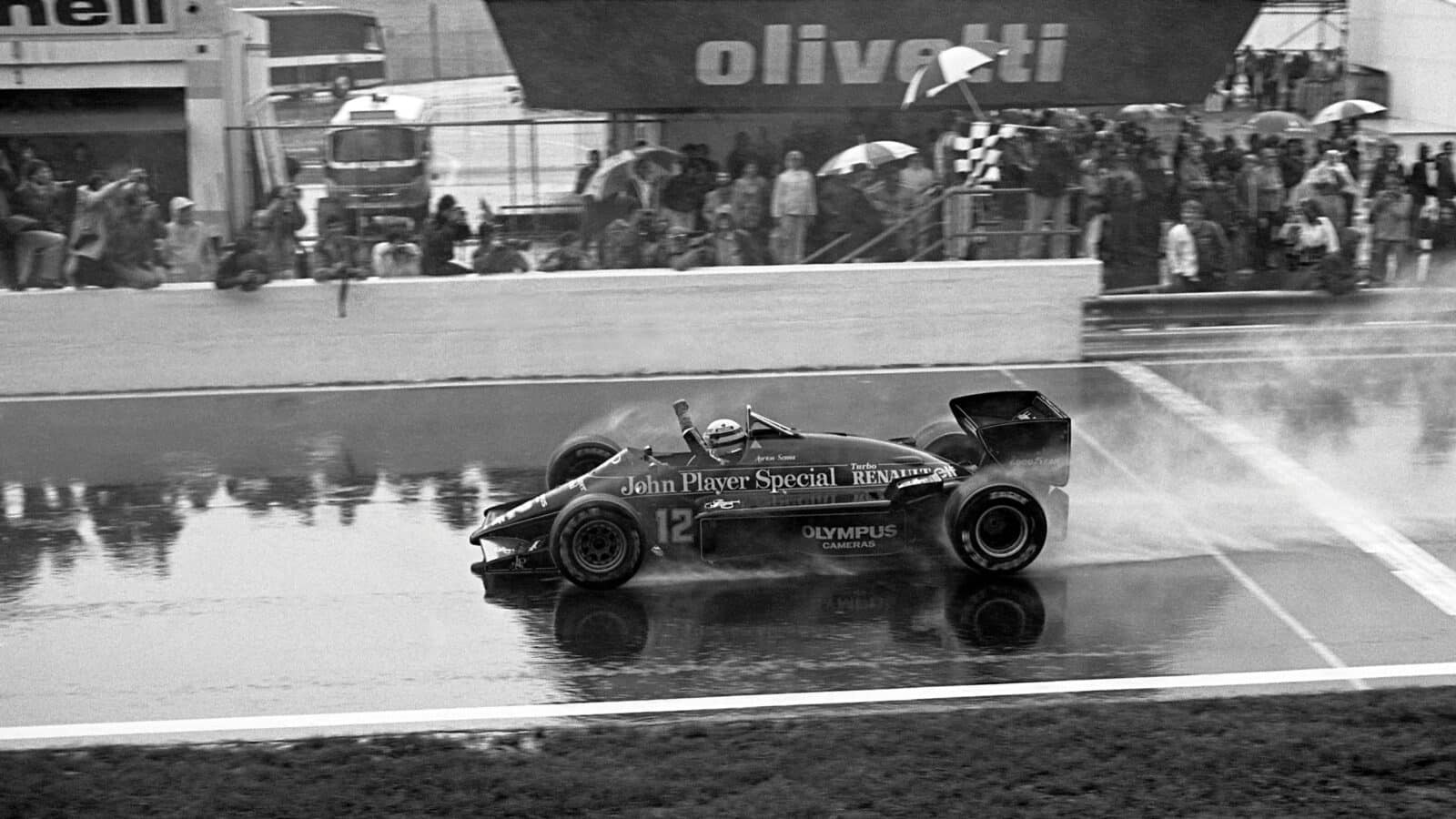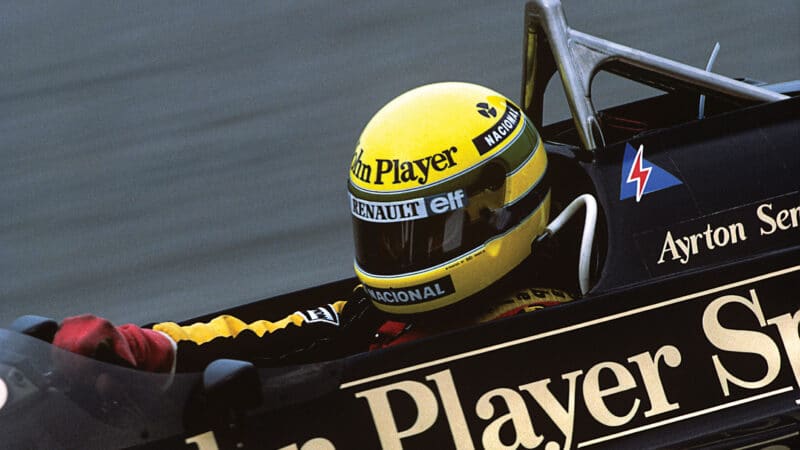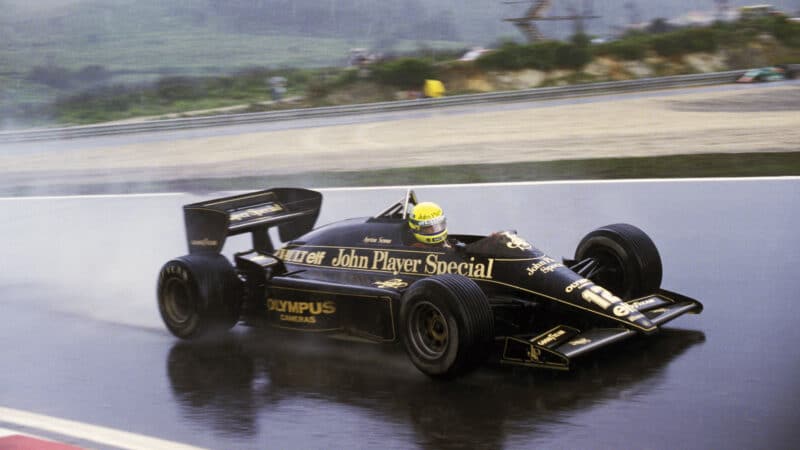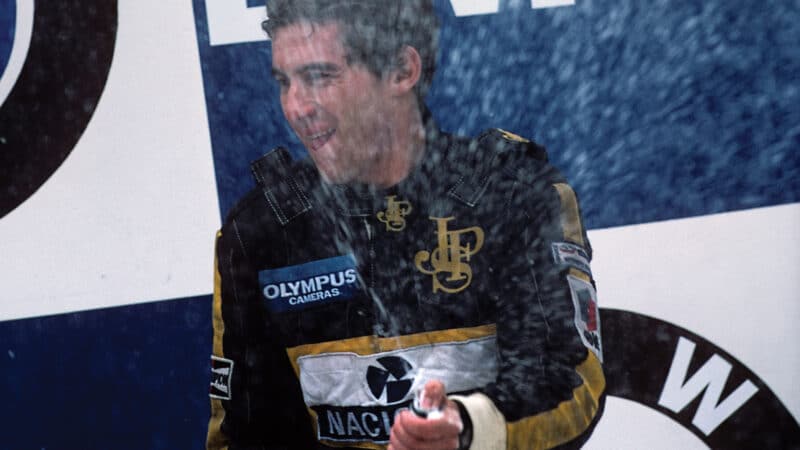Ayrton Senna’s rain dance: his sensational first F1 win
Estoril in 1985 marked Ayrton Senna’s arrival as an F1 class act. Maurice Hamilton was there to witness that famous win in the wet

Getty Images
Murray Walker is peering at the small screen in the BBC TV commentary box, bracing himself for what is likely to be an eventful 1985 Portuguese Grand Prix. At the end of a sunny morning, heavy clouds have rolled in from the Atlantic and show no sign of dispersing.
All 26 starters have chosen wet weather tyres; an easy decision to make since the narrow Estoril track is already glistening, run-off areas are few and the crash barriers menacingly close in many parts of the 2.7-mile lap.
On pole position sits a stylish Lotus 97T, its purposeful appearance accentuated by a black and gold livery in deference to the title sponsor’s John Player Special brand. This is the first pole position for Ayrton Senna, who is seen as the possible spoiler of a second season of domination by Marlboro McLaren and its TAG turbo engines. The Lotus uses a Renault V6 although, in truth, surging turbo power is the last thing any driver needs on an old-school track as slippery as this.
It is going to be a stern test, particularly for Senna in what will be only his 16th grand prix. Alain Prost, sharing the front row in his McLaren MP4/4, has 74 grands prix to his credit, a few less than either Keke Rosberg (Williams–Honda FW10) or Elio De Angelis (Lotus 97T) as they line up on the second row. In wet conditions such as these, anyone could win. A good start will be vital.
“And it’s Ayrton Senna in the JPS Lotus, leading a grand prix for the first time in his short career!” shouts Walker. Senna extends his advantage through the first corner and on the downhill run to a pair of right-handers. Coming out of the second, the tail of the Lotus kicks to the left. Senna swiftly collects the slide without losing momentum.
“So,” says Walker, “Ayrton Senna is finding for the first time what the handling of the JPS is like on a wet track surface…” At which point his co-commentator, James Hunt, gently adds: “I don’t think it really matters what the Lotus is like. He’s got such a prodigious talent.” That’s all he says, almost matter-of-factly, before Walker returns the tempo to full volume.

Ayrton Senna managed just two laps in the Lotus 97T at the season-opening Brazilian GP; two weeks later at Estoril, it would be a different story
Getty Images
Hunt speaks with such quiet confidence, it is both disarming and effective. In view of what is about to happen during the next two hours, there will be no better summary as the judgement of the 1976 world champion is proved to be pin sharp. F1 is about to witness a beautiful geometry of technique and precision that will establish Ayrton Senna as a star operating on a different level to everyone else. In truth, it had been a revelation waiting to happen. For 11 months and 19 days, to be precise.
On Sunday, June 3, 1984, Ayrton Senna had grabbed the headlines five races into his F1 career. Politely refusing the early offer of support in F3 from McLaren in return for a future grand prix drive, Senna had chosen to learn the F1 ropes with Toleman, a compact little team struggling with a tight budget and a car that was pragmatic rather than pretty. The limelight rarely stretched to the bottom half of the grid, which suited Senna. But that began to change in June at Monaco when Ayrton qualified on the seventh row, just behind a Lotus and ahead of an Alfa Romeo.
He was destined to move forward quickly during the race as rain shifted the balance in favour of each driver’s skill rather than the competitiveness of his car.
The conditions became so bad that the race had to be stopped, just as Senna caught and drew alongside the leader, Prost. Had it not been for a one-lap count back determining the result, Senna would have won his first grand prix in a Toleman-Hart. And yet, rather than be satisfied with a sublime second place, his earnest complaints about the premature finish laid down an interesting marker alongside his stunning kinship with driving in the rain.
When similar conditions descended upon the Portuguese Riviera a year later, expectations were high. The difference for Senna this time would be the anticipation attached to driving for a former world championship team rather than one owned by a transport company and powered by a four-cylinder turbo made in Essex.
Lotus, in fact, had tried to capture Senna’s signature for 1984. Agreement had been reached between the Brazilian and Peter Warr, team principal at Lotus, but the choice had been vetoed by the Lotus team’s lead sponsor and its preference for Nigel Mansell. Warr, never a fan of the British driver, would note the irony of Mansell spinning away the lead at Monaco on a day when Senna was captivating the watching world. Warr also knew that, going forward, Senna’s Monaco performance would, at the very least, add a zero to the £50,000 retainer prematurely agreed for 1984.
Warr had considered himself fortunate to settle on the £585,000 fee asked by Senna for 1985. Toleman, in possession of a three-year contract with its star driver, was not so happy. A messy announcement of the Lotus deal on the weekend of the 1984 Dutch Grand Prix resulted in Senna receiving his comeuppance at the next race in Italy. A buy-out clause in the Toleman contract stipulated a certain sum had to be paid, even before any negotiations took place. Not only had Senna failed to pay the £156,000, he also seemed to believe that Toleman would understand his career had to come first.

Ayrton Senna managed just two laps in the Lotus 97T at the season-opening Brazilian GP; two weeks later at Estoril, it would be a different story
Getty Images
When he arrived at Monza, Senna was shocked to find that Toleman had given his car to Stefan Johansson. This was difficult on several fronts, not least because Italy would be the home grand prix for Sergio Tacchini, the achingly fashionable sportswear company with whom Senna had a personal sponsorship deal. Dressed in an immaculate white Tacchini tracksuit, Ayrton looked like a lost soul as he wandered round the paddock. “I don’t want any more aggravation,” the Brazilian kept repeating. “I just want to go motor racing.” It was a tough way to learn that an F1 driver is not simply about being supremely quick. But the logic of Senna’s career decision was about to be proved emphatically.
“Few reckoned Lotus would be a match for McLaren or Ferrari”
The 1985 season opened in Brazil, where Senna qualified fourth and retired with a fuel system problem. When previews were written for the next race in Portugal, very few reckoned Lotus would be a match for McLaren or Ferrari. Opinion began to shift when Senna was fastest on the opening day and improved on Saturday to claim pole position. The Lotus-Renault had balance and power – and a driver clearly capable of making the most of it. Then the odds moved even further in favour of the man in the yellow crash helmet when the advancing weather front laid down a slippery canvas perfect for this creative genius.
At the end of the first lap, Senna led by 2.65sec. The gap extended by roughly the same amount on each succeeding lap. A clear track played its part but Senna was about to prove that the benefit of unimpeded vision was not as valuable as his surging pace seemed to suggest. Within five laps, he was among the backmarkers – and slicing through as if they were standing still. A second or two may have been added to each lap, but a gap between Tyrrell drivers Martin Brundle and Stefan Bellof in 12th and 13th places allowed Senna to really show what he was worth on lap 15.
The Lotus stopped the clocks at 1min 44.121sec. Such were the tricky conditions, this may have been a full 23sec slower than pole – but it was in a different time zone compared to everyone else, even allowing for drivers being embroiled in the swirling atomisers created by traffic. On the same lap De Angelis, in second place, recorded 1min 46.027sec; Prost (third) 1min 45.898sec and the Ferrari of Michele Alboreto (fourth) 1min 45.906sec. Everyone else was in the high 1min 46sec – and beyond. Senna was showing no indication of backing off.
“I could not see anything,” said Ayrton. “With the cars going in front, was impossible. You had to go by because [there] was a big difference in the pace that I was going.” Talk about understatement. By half distance, that need to ‘go by’ put Senna one lap ahead of Niki Lauda’s McLaren in sixth place and closing on the Renault of Patrick Tambay in fifth. After 43 laps, Senna was 58sec ahead of Alboreto. The lead had extended thanks to Prost joining several others, including Rosberg, Gerhard Berger and Riccardo Patrese, as they spun off.
“I was completely out of control and the car just came back”
Senna’s race had not been without incident. On lap 30, his lap time had gone out to 1min 53sec – his slowest by some way. Ayrton was relieved to have been able to complete the lap after putting all four wheels on the grass on the downhill sweep to the second corner. “People said it was fantastic car control,” Senna said later. “No way. I was completely out of control and the car just came back.”
Prior to the race, lap charts had been marked to show three-quarter distance; a significant point if the 70-lap race was to be stopped and full points awarded. That seemed inevitable as the 52-lap mark approached and the rain actually intensified; worse than it had been at any stage during the previous hour and a half. As if to remind officials of the regulatory option, Senna began signalling urgently as he passed the pits. But the race continued.
The tension within the JPS pit became unbearable. Lotus had not won a grand prix since 1982. It did not want to lose this one now. Another 15 excruciating laps went by. At the two hour mark, Senna emerged from the murk for the 67th and final time, the chequered flag bringing an end to this monumental performance. The winning margin was more than a minute. He had lapped everyone except Alboreto.
In an explosion of relief and elation, Senna popped his belts, his shoulders surging clear of the cockpit sides as he began furiously waving his arms and red-gloved hands in the air. This untrammelled ecstasy was replicated in parc fermé as the bedraggled Lotus crew, led by a euphoric Warr, literally jumped for joy as the grimy racing car came to a halt. In his role as press officer for JPS Lotus, Tony Jardine was among the welcoming committee at the end of the pitlane.
“It was absolute bedlam!” recalls Jardine. “The Portuguese officials were trying to stop us getting past the barriers and our guys were going crazy. We were completely saturated, but it didn’t matter. My main mission was to produce a press release as soon as possible. Once Ayrton had come back from the podium, we went into the truck. The guys, all in a fantastic mood, had started packing. We found a bit of space down the back. Despite the excitement going on around us, Ayrton was incredibly calm – and typically analytic, recalling everything. It was almost as if he expected this win. He described the car as floating on the water, almost beyond control and actually quite dangerous at times. But it was said without him being sensational in any way. There was no question in any of our minds that this was the first of what would be many wins. Ayrton had this incredible self-belief and presence.”
Senna went on to win in Belgium. It was another drive of consummate brilliance, this time in wet-to-dry conditions with the added complication of a treacherous shower half way through. He would also lead at Imola, Monaco, Detroit, Silverstone, Nürburgring, Brands Hatch and Adelaide. Only one of his seven retirements would be the result of driver error. Despite disappointing results (due mainly to the engine and its ancillaries), word of this potential superstar spread.

Another drenching, this time from a jubilant Senna – his first F1 win; 40 more would follow
Late in the season, I was commissioned by Life to write a piece on the 25-year-old who had clearly caught the editorial eye of a magazine whose readership, it was grandly claimed, was a quarter of the population in the US. Walking back from the pole position winner’s press conference (Senna’s seventh of the season) at the final race in Adelaide, I enquired about an interview. We agreed to meet in the off-season at the large new-build he was renting with Mauricio Gugelmin and the Brazilian F3 driver’s wife, Stella, in a quiet cul-de-sac in the posh London suburb of Esher.
It was a bizarre experience in this largely unfurnished house as the four of us sat around a pine picnic table in the kitchen. The interview lasted the best part of 45 minutes. It was relaxed and friendly, helped by Mauricio and Stella often chipping in comments as we munched from a bowl of peanuts. We talked about his health (Ayrton had suffered from a nasty sinus infection at the beginning of the season); his relationship with the Lotus team and dealing with the British sense of humour; life for a Brazilian in England; his driving style and unique habit of urgently blipping the throttle through corners; his attention to detail when setting up the car.
Asked about his expectations going into the season just finished, Ayrton said: “When I went to Lotus, the first thing I expected was to be very competitive. As a consequence of that, do my first pole position in Formula 1 and win my first grand prix. That was the first thing. I achieved that in my second race in Portugal, so that was very good, especially under the circumstances.
“After that, it was just a matter of keeping going; try for another pole position, another win, and so on. I won my second grand prix at Spa, again under difficult circumstances. So that was even more rewarding than for what you might call a normal win. But the taste of that [win at Spa] was nothing like Portugal; nothing like. Not even 10%. The taste for Portugal, pole position, the win, was really… I guess I could compare the pole position with some of the others through the year – they gave some excitement. But the win…. That was nothing like anywhere, in any other race.”
Eight years and 39 wins later, Senna would mention Portugal ’85 in a similar light when asked about a drive of dazzling virtuosity in the 1993 European Grand Prix at Donington.
“People say my win in the wet at Donington was my greatest performance,” he said. “No way! I had traction control! OK, I didn’t make any real mistakes, but the car [McLaren-Ford MP4/8] was so much easier to drive. It was a good win, sure. But compared with Estoril ’85, it was nothing.”
It was sincere vindication the world had been blessed to witness – to paraphrase James Hunt – a prodigious talent at its thrilling extreme for two hours in Portugal on April 21, 1985.
